(5/10) Often cited as the worst dinosaur movie ever made, Unknown Island from 1948 is the first Lost World film in colour. A good cast spearheaded by SF star Richard Denning, nice atmosphere and a decent script balance out the wobbly dino costumes and elevate this one above its shoddy reputation.
Unknown Island. 1948, USA. Directed by Jack Bernhard. Written by Robert T. Shannon & Jack Harvey. Starring: Virginia Grey, Richard Denning, Phillip Reed, Barton MacLane, Dick Wessel, Crash Corrigan. Produced by Albert J. Cohen. IMDb: 5.2/10. Rotten Tomatoes: N/A. Metacritic: N/A.
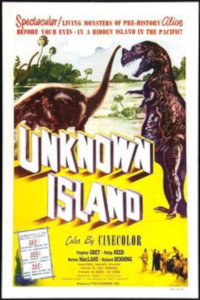
American adventurer Ted Osborne (Phillip Reed) and his fiancée Carole Lane (Virginia Grey) arrive at a seedy Singapore bar, looking to hire a ship and crew to take them to an island supposedly inhabited by dinosaurs. They team up with the foul-mouthed, scheming Captain Tarnowksi (Barton Maclane) and his first mate Sanderson (Dick Wessel). The two latter also recruit the supposedly insane alcoholic John Fairbanks (budding SF star Richard Denning), who suffers from PTSD after being marooned on said island, where he claims giant monsters ate all his fellow survivors of a shipwreck.
The five set off on a crewed ship toward a Polynesian island, where, surprise, surprise, they run into a whole bunch of dinosaurs, many of them looking suspiciously like actors wobbling along in heavy rubber suits. Fairbanks, now sober and in hero mode, immediately starts arguing for a swift return home, as not to endanger he life of beautiful Carole Lane, who refuses to stay on the boat like some fragile flower. Osborne, less worried about his fiancée’s safety than about getting sensational photographs of the dinosaurs, refuses, initially. Then the dinos attack, and our heroes fight them off with guns, grenades and fire. When a few sailors, including the first mate, get eaten by dinosaurs, though, even Osborne sees reason. But at this time, tension has been brewing between Captain Tarnowski, Fairbanks and Osborne, all with their eyes on pretty Ms. Lane. Tarnowski, determined to get something out of the trip after having lost his first mate, decides he is going to capture one of the beasts and bring it back to civilisation. All is, naturally, set up for a showdown between heroes, villains and dinosaurs with a damsel in distress in the middle. And this time the damsel isn’t kidnapped by a giant ape, but rather by a horny captain. Oh, and there’s also an epic battle between a dinosaur and a “giant sloth”, played by stuntman Ray “Crash” Corrigan in one of his modified ape suits, looking suspiciously un-slothlike.
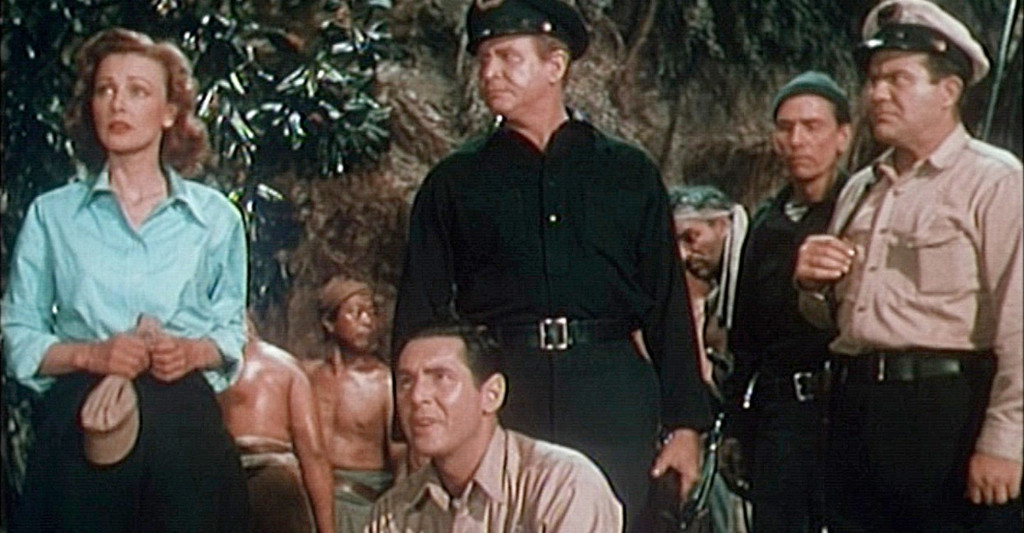
Friends of lost world movies will immediately recognise Unknown Island as the bastard child of The Lost World (1925, review) and King Kong (1933, review), which in itself was something of a Lost World ripoff, but with the addition of Gaston Leroux’s Balaoo and Mary Shelley’s Frankenstein. Both these films benefited greatly from the pioneering stop-motion work done by Marcel Delgado and Willis O’Brien, a large special effects budget and the resources of a major studio. Unknown Island is not so lucky, as it was produced by a small independent outfit called Film Classics. Apart from this, and the fact that Unknown Island was made in colour, there is actually very little difference between these films. The script for The Lost World was slightly better, but the script for Unknown Island isn’t dreadful, it’s mainly derivative and by-the-numbers, and sports an unhealthy dose of misogyny. Truth be told, the script for King Kong was also terrible. But the script isn’t the, ahem, dinosaur in the room. It’s those wobbly rubber dinosaurs. One technique this film doesn’t use, at least to my recollection, is so-called “slurpasaurs”, or optically enhanced lizards to resemble giant monsters. Instead, and to the filmmakers’ credit, they are created through special effects and suits. This, of course, doesn’t mean they look very good. Still, they look a lot better than many of the low-budget monsters created by Roger Corman’s AIP and other Poverty Row outfits in the fifties. There are brontosauruses created by either dummy work or stop-motion, a dimetrodon, which is obviously a non-mobile prop being dragged along the studio floor with wires (its legs are — sort of — moving) and a group of extras in the famous rubber suits. The suits themselves are already pretty crappy, but it gets a hundred times worse as soon as they start moving, as it’s obvious that the actors inside have very little control over the lizards’ motor functions and they look like wobbly jello when walking.

One should remember that this was still the days before Godzilla (1954, review), and that the Japanese special effects team struggled — with legendary results — to find a way to make a man in a rubber suit work as a convincing giant lizard. One problem was that it was difficult to make rubber suits that were durable, easy to mold and light enough for the actors to wear. Another was that any suits made out of rubber would be impossibly hot. To my knowledge, only one film prior to Unknown Island ever used a full-body dinosaur suit; One Million B.C. from 1940, and in that film the allosaurus in question is only ever seen at a glance. In Unknown Island they are seen frequently, in long, long takes. The brontosauruses and the dimetrodon are not very well realised, but they are perfectly adequate for a film of this type. It’s the wobbling “T-Rexes”, as they are called in the film, that make this movie show up on so many “worst monster movies” lists. In fact, the dinosaurs in question are modelled on ceratusauruses, which were smaller than the Tyrannosaurus Rex, and had a horn on their noses. It’s clear that the actors can’t walk very well in the suits, and have to sway from side to side only to take tiny steps forward, giving the terrifying monsters a hilarious wobbling gait. It doesn’t help that their necks and arms aren’t very rigid, which means that as they walk, they get a certain jello-like appearance as the head and forelegs bounce from side to side. There seems to be no way to animate the arms or the mouth, so as the creatures fight, they simply wobble into each other, making them look like those people in fat-suit wrestling games you see at festivals and fairs.

The script actually sets up a fairly interesting premise, not least because there’s some mystery surrounding the characters. At the get-go, it isn’t clear exactly who the two adventure-seekers are, other than the fact that Virginia Grey’s character is a rich woman with little scruples and Phillip Reed’s is a daring adventurer who, for some reason or the other, wants to find the dinosaurs. The problem is that we are none the wiser when the film ends. Apparently, as is stated again and again, Ted Osborne wants to take pictures of the dinos, and he seems to be an accomplished photographer, but that’s all the information we get. Is he a scientist? An explorer? A reporter? A businessman? We will never know. Why Carole Lane is interested in the lizards is never made clear, other than she seems to have a lot of money to spend. But that feisty, world-weary attitude we see from her in the beginning of the film immediately evaporates as she sets foot on the island, where she becomes your typical damsel in distress. Grey is great in the role, but she isn’t helped by the inane script, which has her casually forgetting all about an attempted rape by Captain Tarnowski. Phillip Reed also isn’t bad, but as David Demoss puts it at the site And You Thought It was Safe?: “Reed’s even more aware of how paper-thin Ted Osborne is than I am. Look into his eyes and face an actor completely lost”.
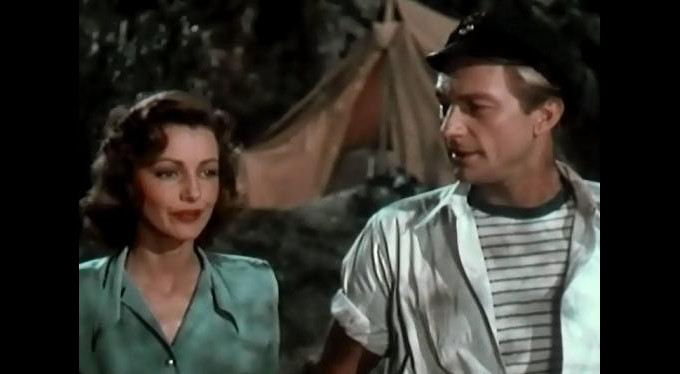
Character actor extraordinaire Barton MacLane is wonderful as the asshole Captain Tarnowski. But again the script makes it difficult for the viewer to take his character seriously. Even though the world is full of assholes, people usually choose at what point to bring out their assholyness. For example, when attacked by giant monsters isn’t, in my experience, the exact moment when people start scheming in order to get under the sheets with someone else’s fiancée, nevermind trying to rape them in the middle of a circle of tents where her husband-to-be and loyal defender Mr. Hero are sleeping. The tiresome trope of the triangle drama under dinosaur threat is one that shows up in almost all lost world movies, and one that can trace its lineage straight back to The Lost World, however in that film the drama unfolded in a, shall we say, less clumsy fashion. And if The Lost World and King Kong were marred by the fact that we lose track of the characters when the special effects take over, the problem with Unknown Island is that there is no personal argument so petty as to be overshadowed by the fact that all of the characters are about to be eaten by giant monsters. And that’s a problem caused by bad character writing. Screenwriters Robert T. Shannon and Jack Harvey have written all characters as a single trait. Ted is the fiancé who loves his work more than his wife to be, so that’s what he does in the film, the only thing he does in the film. Fairbanks is the redeemed hero, who’s the moral compass and dashing leading man. So that’s his entire character “arc”. The captain is the asshole villain, so he’s the asshole villain from first to last shot, every scene and every line is just there to showcase what a villainous asshole he is. And Lane is, when it all boils down to it, is simply there to be a love interest and a damsel in need of saving.

On the other hand: at 75 minutes this film doesn’t overstay its welcome. It’s a nifty, well-contained, adventure thriller. The low budget adds to its claustrophobic feel, which director Jack Bernhard, with a background in horror and gangster noir, knows well how to build. As Cinema Delirium points out, the crew is top notch: the film “was edited by Harry W. Gerstad, who was a two-time Oscar winner — including for the stone cold classic High Noon (1952); the DP was Fred Jackman Jr who did uncredited special effects on Mr. Smith Goes to Washington (1939); the set dresser was Robert Priestley who worked on many prestige productions including Gilda (1946) and Cat on a Hot Tin Roof (1958). These guys were industry veterans and even if the budget of the film they were working on was lower than they were used to you still got the benefit of their experience and artistry.” Jack Bernhard himself had been associate producer at Universal for some of the studio’s least prestigious, but strangely well-functioning horror films, like Man Made Monster (1941, review), Horror Island (1941) and The Strange Case of Doctor Rx (1942). Plus, the cast is a good one, with Richard Denning carrying the hero mantle with natural ease. There’s a reason as to why Denning was such a popular hero for B movies. An accomplished actor, he had a well-rounded balance of working class roughness with an air of intelligence, and something dark brooding behind his eyes, which meant his leading men often had at least an illusion of depth and complexity to them. That’s one of the reasons he worked so well opposite Richard Carlson’s goody-two-shoes leading man in Creature from the Black Lagoon (1954, review).
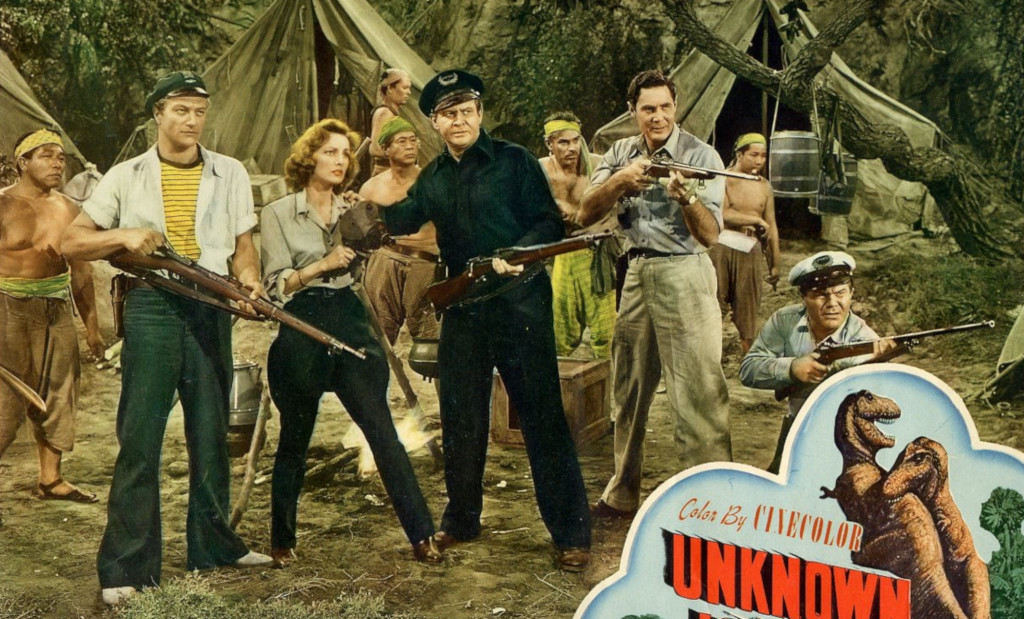
Unknown Island received a negative review in The New York Times upon its release, with Bosley Crowther calling it “a pretty flabby piece of fanciful movie-making”. Crowther also notes that “the film is in Cinecolor, dominated by a shade of sickly green”, which brings us to an interesting point. Yes, the movie is in colour, which was a rare choice for a low-budget outfit making a B horror picture. On this blog we have previously written about a couple of horror SF movies made in colour — with the old two-strip Technicolor process, a time-consuming and expensive process requiring special cameras, editing equipment and supervision from the Technicolor company. Rivalling colour processes were developed beside Technicolor, and one was Cinecolor, which was unveiled in 1932. Like two-strip Technicolor, Cinecolor was a bi-pack subtractive colour process, meaning two strips of film were loaded into the camera. In the case of Cinecolor, they used one panchromatic (b/w) and one orthochromatic (colour) film. The orthocromatic film was not able to react to red, meaning red colours passed through, leaving the film undeveloped. That’s why this film strip was dyed red, leaving undeveloped areas a bright, fleshy red-pink. The film also couldn’t reproduce yellow or bright green, bringing the greens down to a very dark hue, almost black, which actually works perfectly for this film.
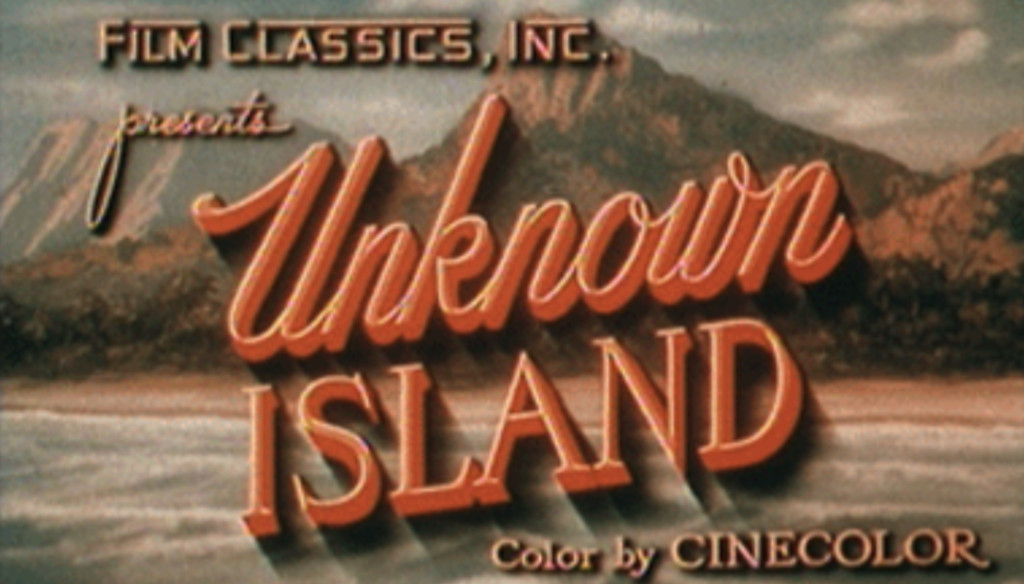
Cinecolor was primarily used for short films and cartoons early on, but from the mid-forties a number of feature films were produced with the process. By this time Technicolor had already revealed its three-strip process, allowing for a full range of vivid colour, making Cinecolor appear somewhat murky in comparison. But Cinecolor had one definite advantage over Technicolor: It could be filmed with an ordinary film camera, instead of the bulky, expensive machines used by Technicolor, and the printing process was fairly straightforward. This meant that Cinecolor was fast and cheap. It was only 25 percent more expensive to film in Cinecolor than in black and white, and finished prints could be turned out 24 hours after filming. While the colours of Unknown Island are not entirely natural, and have a somewhat murky hue, they lend the film an interesting look, and are one of the reasons this is still so enjoyable today.

According to the great Movies & Mania (formerly Horrorpedia), filming began in May 1948 and it premiered in October the same year. Advertising touted that it was “one year in the making”, probably to hype the special effects. All footage of the principal actors were done on sound stages, bringing in the usual Hollywood jungle sets for the jungle. The extras in dino suits were filmed by the second unit in Palmdale and in Corriganville, California, which was the ranch of stuntman and suit actor Crash Corrigan; “All shots of the actors and monsters in the same shot were achieved with rear projection effects”. Movies & Mania also reports: “In a 6th June 1948 New York Times news item, producer [Albert] Cohen claimed that the film’s budget was $450,000 and that about 35% of that figure had been spent on creating and photographing the prehistoric monsters.”
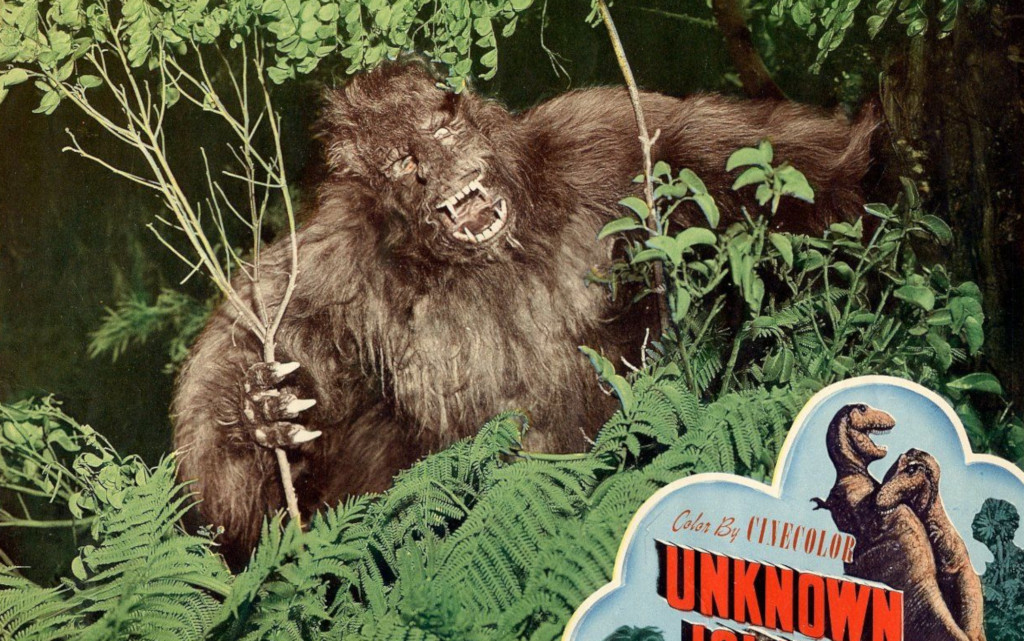
Unknown Island has a very shoddy reputation. The film has a lowly 12% audience approval on Rotten Tomatoes and a 5.2/10 rating on IMDb, which, granted, isn’t terrible, but most films under 5.5/10 on IMDb usually fall into or under the C film category. It’s also on a number of people’s “worst ever” lists. For example, the multi-talented and award winning Jessica Amanda Salmonson or “Paghat the Ratgirl” reviews crappy dino films at Wild Weird Realm, and calls Unknown Island “one of the worst of a bad lot”. Digital Spy has it at number 8 of the 12 “most embarrassingly mad horror movie monsters” of all time (yes, I know the article says number 5, but they’re counting the wrong way). The magazine writes: “Would that this island had remained unknown”. In a list of dinosaur films, The Guardian says this about Unknown Island: “This is poor in pretty much every conceivable way, and the man-in-a-suit tyrannosaurs are hilariously bad as they are almost literally incapable of movement and can barely stand.” TV Guide is no less forgiving, awarding the film with 1/5 stars, writing: ” The dinosaurs are absurdly fake and the script has no surprises, only cliches”. And pseudonym Kloroxx at French-language Cannisaurus gives the movie 3.5/10 stars. Kloroxx states: “While Bernhard’s film is not a complete train wreck, possessing, despite its flaws, a certain charm as well as an air of “so bad it’s good, it can ultimately continue to remain an unknown island for those of you who have not yet discovered it.”

AllMovie steps up the rating to 2/5 stars, and Craig Butler concludes his review: “The cast tries hard and is actually pretty good for this kind of film; still, unless you just have a weak spot for this type of flick — and many of us do — it’s good to give it a pass.” Richard Scheib at Moria mirrors AllMovie’s rating, calling Unknown Island “a routine entry” with “cheap and shabby” dinosaurs and “purple” dialogue. The Movie Waffler likewise gives the movie 4/10 stars, writing that it looks like the actors playing the dinosaurs were recruited “from the local drunk tank”; “They bump into and fall over each other like a surreal cross between The Banana Splits and the shambling zombies from Night Of The Living Dead“. Some critics, however, have been able to see past the ludicrous lizards. Pseudonym Lan at French Oh My Gore states that “although very cheap and a bit dated, The Unknown Island is an entertaining movie full of charm, to be classified in the category of nice but forgettable “so-bad-they’re good” films”. Oh My Gore gives the picture 5.5/10 stars. Another pseudonym, El Tofu (oh what’s with all the pseudonyms?) at German site Tofu Nerdpunk, awards the film with a generous 6/10 stars, writing: “If you are not deterred by the many flaws, it will give you some really funny moments and should thoroughly entertain you during most of its running time”.
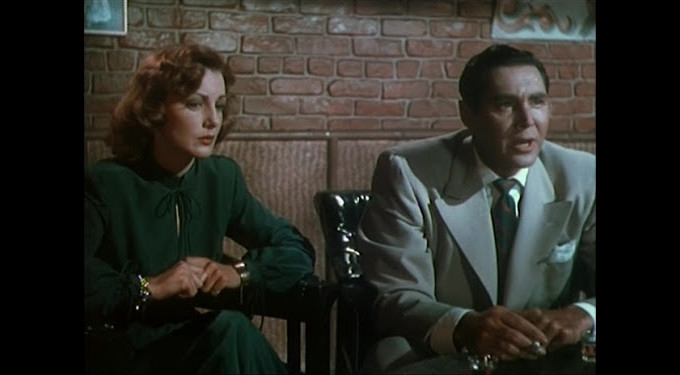
I’m inclined to agree with the latter critics. I’ve found that Unknown Island is an entertaining movie and holds up for numerous viewings. Up until the wobbly dinos, it’s a fairly atmospheric and compact character-driven adventure thriller, be it that the characters are cardboard cutouts. And if you’re not too offended by the hilarious scenes where off-screen actors throw grenades at extras hobbling along at a snail’s pace in cumbersome rubber suits, you’ll get a mighty fun evening. Plus, Virginia Grey, Richard Denning and Barton MacLane are always good, no matter how bad the movie.
Whatever the merits of Unknown Island, it jump-started a genre that had laid dormant for some while. Of course, there is a reason why rather few films featuring dinosaurs were made in the silent era and the thirties: It’s not an easy task to bring dinosaurs to the screen in any realistic fashion. The first movie featuring dinos was probably D.W. Griffith’s caveman movie Brute Force from 1914, which had a very unconvincing large-scale prop of a T-Rex and a baby alligator with sails and whatnot glued to it (a popular and not especially animal-friendly trick). Stop-motion dinos were seen in the short The Dinosaur and the Missing Link (1917) and The Ghost of Slumber Mountain (1918, review), courtesy of Willis O’Brien. Another stop-motion animated brontosaurus featured in a scene in the Buster Keaton movie Three Ages and was animated by the forgotten Charles R. Bowers. But it was The Lost World and King Kong that brought stop-motion animated dinosaurs and monsters to the front and center, in the process also setting the bar so high that few after this even attempted the feat. One exception was the 1940 caveman film One Million B.C. This was probably the first film to use so-called slurpasaurs, as a number of lizards and reptiles were blown up on screen to represent prehistoric monsters. The special effects were added to a stock footage library and consequently reused in numerous pictures. Especially memorable, perhaps for the wrong reasons, is a scene in which a dwarf alligator fights with a tegu lizard, leaving the latter severely injured. But during WWII, very few films featuring Americans meeting monsters on Pacific islands were made in Hollywood, perhaps because US soldiers were being killed on those same islands in real life. It took eight years for the next dino film to be made, and that was Unknown Island, which then opened the flood gates, as the fifties came roaring with science fiction and lost world adventure stories. We got Two Lost Worlds (1950, review), Lost Continent (1951, review) and finally The Beast from 20,000 Fathoms (1953, review), which in turn inspired Godzilla (1954). And then all hell broke loose.
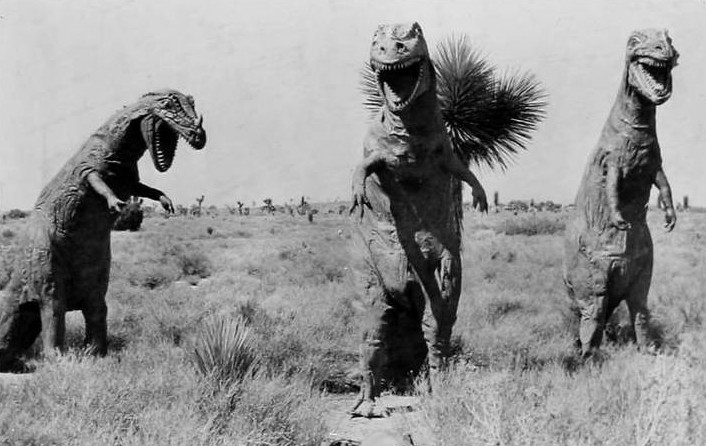
Unknown Island, as many similar stories, including Doyle’s The Lost World, was an amalgamation of three distinct, but often combined, literary tropes, the Fantastic Voyage, the Lost World and the Prehistoric Monster tropes. While most of these had been around since the very first literary works, the first modern author to describe a lost world with a prehistoric fauna in a “realistic” novel was probably Simon Tyssot de Patot, with Voyages et Aventures de Jacques Massé (1714), which he followed up with La Vie, les Aventures et le Voyage de Groenland du Révérend Père Cordelier Pierre de Mésange (1720), translated and collected by Brian Stableford in 2015 as The Strange Voyages of Jacques Masse and Pierre de Mesange. Jules Verne’s Journey to the Center of the Earth (1864) also described a number of dinosaurs and (maybe) a giant humanoid. Edward Bulwer-Lytton’s The Coming Race (1871) is more renowned for its depiction of an advanced, lost race of humans living underground, harnessing the mental power of Vril, and inspiring the myth of ancient Egyptians. But the book also contains giant dinosaur-like lizards. Sir Arthur Conan Doyle wrote The Lost World in 1912, and no doubt inspired Edgar Rice Burroughs to write his Pellucidar series about a vast world in a hollow Earth with his first book At the Earth’s Core in 1914. And it is probably no coincidence that the first films containing dinosaurs started appearing shortly after these two novels.
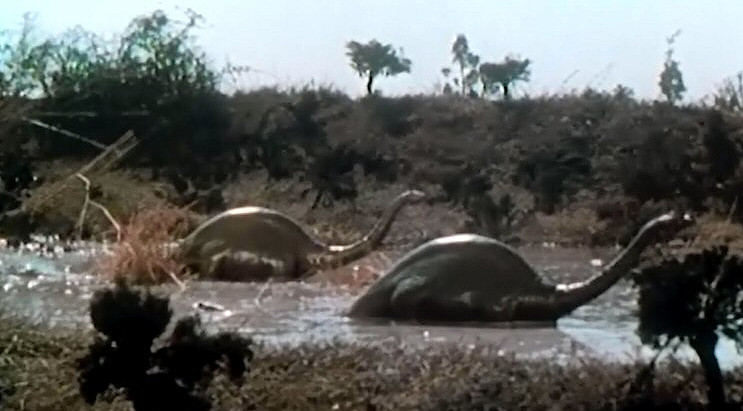
As stated, the acting is not at fault in Unknown Island. Richard Denning was a “working actor” with a background in Paramount’s stock company, where he played lesser roles in big films and bigger roles in lesser films, and had a number of B-movie leads under his vest when his career was put on hold during WWII, when he served on submarines. But he bounced back well as a freelancer, now married to Universal’s scream queen Evelyn Ankers, well known also to readers of this blog. His first science fiction movie was a gadget macguffin reel called Television Spy (1939) and the next was Unknown Island. However, he became a minor star in 1952 when he starred in the titular lead of the television series Mr. and Mrs. North, about a married couple solving crimes as amateur sleuths. The show was a success and ran for two seasons. However, he is perhaps best known for his role as second male lead in Universal’s SF classic Creature from the Black Lagoon (1954), playing opposite Richard Carlson and Julie Adams.
Denning would go on to more television fame in the Australian series The Flying Doctor (1959), as detective Michael Shane (1960-1961) and as father Steve Scott on the family sitcom Karen (1964-1965). Just as he was about to retire in Hawaii in 1968, he was lured into playing the role he is perhaps most famous for, the mayor in Hawaii Five-O (1968-1980). He was also a known voice on the radio, after having starred opposite Lucille Ball in the program My Favourite Husband (1948-1951). But in between TV roles, there was a period when Richard Denning was the hottest science fiction star in Hollywood, as he racked up lead after lead in sci-fi movies, starting with Universal’s smash hit Creature from the Black Lagoon. He followed up with Target Earth (1954, review), Creature with the Atom Brain (1955, review) Day the World Ended (1955, review), The Black Scorpion (1957, review) and finally Twice-Told Tales (1963).
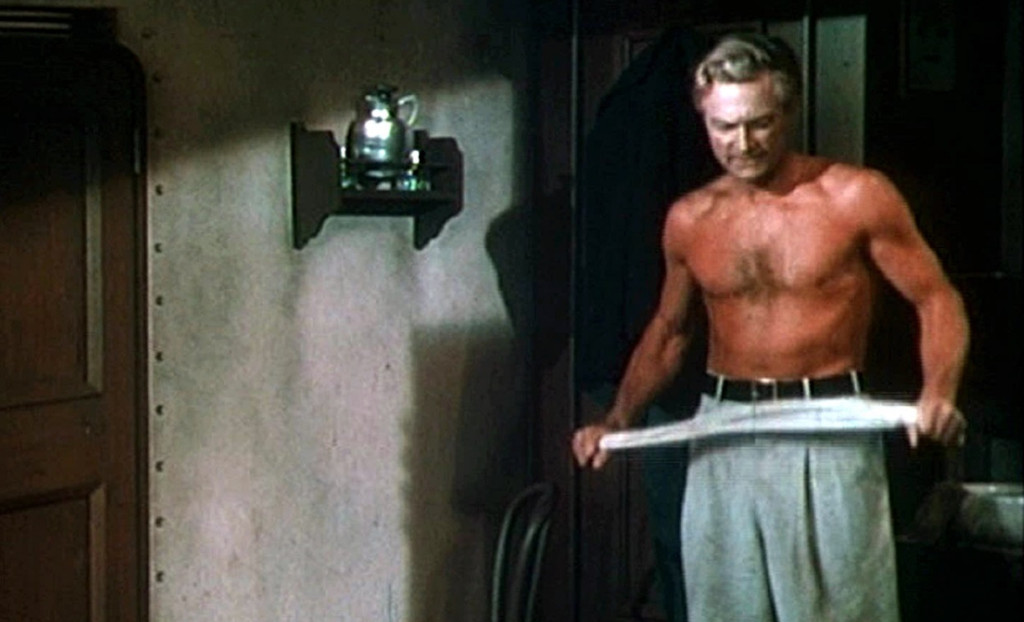
Unlike Denning, who grew up expecting to take over his father’s garment manufacturing business, Virginia Grey was born into acting. Her father was director Ray Grey, and she made her film debut in the silent film Uncle Tom’s Cabin in 1927, at age 10. She made around a dozen films as a child actor, took a break to finish school, and returned to the screen on 1933. While never the biggest star on the screen, Grey had a long and steady career in both film and TV, and did her fair share of leading lady roles, primarily in westerns. As for SF fare, she reunited with Richard Denning in Target Earth in 1954. Today she is perhaps best known for being the on/off girlfriend of Clarke Gable, a man she apparently continued to love throughout the rest of her life, and never married.

Listing the many accomplishments of character actor Barton MacLane would take an article of its own, but suffice to say, he was one of Hollywood’s most demanded supporting actors during the thirties and forties, working with many of the industry’s greatest directors. He is especially remembered for his many films opposite Humphrey Bogart, such as The Maltese Falcon (1941), High Sierra (1941) and The Treasure of Sierra Madre (1948). As for science fiction he also appeared with Boris Karloff in The Walking Dead (1936, review) and with Spencer Tracy in Dr. Jekyll and Mr. Hyde (1941, review), and opposite Lon Chaney Jr. in the horror movie The Mummy’s Ghost (1944).
Janne Wass
Unknown Island. 1948, USA. Directed by Jack Bernhard. Written by Robert T. Shannon & Jack Harvey. Starring: Virginia Grey, Richard Denning, Phillip Reed, Barton MacLane, Dick Wessel, Crash Corrigan, Phil Nazir, Dan White, Snub Pollard. Music: Raoul Kraushaar. Cinematography: Fred Jackman Jr. Editing: Harry Gerstad. Art direction: Jerome Pycha Jr. Makeup supervisor: Harry Ross. Sound: Max Hutchinson. Special effects: Ellis Burman. Produced by Albert J. Cohen for Albert Jay Cohen Productions and Film Classics.

Leave a comment